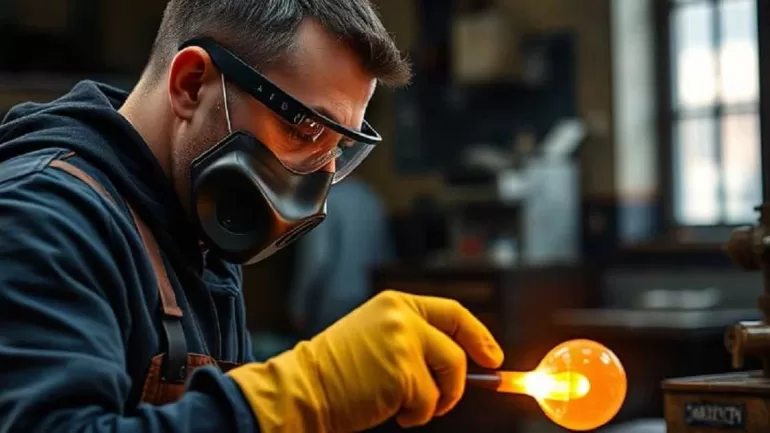ART & DESIGN
Stay safe with our complete glassblowing safety guide—gear, tools, ventilation, and emergency protocols every artist needs to know.
BY KAZEEM ADELEKE, ARTCENTRON
Glassblowing is an ancient art form that merges creativity with science, transforming molten glass into exquisite works of beauty. However, working with high temperatures, sharp tools, and fragile materials also brings substantial risks. Understanding and practicing glassblowing safety is crucial not only for professionals but also for hobbyists. Below, we provide a comprehensive guide on how to stay safe while mastering the art of glassblowing.
Understanding the Hazards of Glassblowing
Glassblowing exposes individuals to multiple safety risks, including extreme heat, cuts from broken glass, toxic fumes, and eye damage from radiant energy. Awareness of these hazards is the first step toward prevention. Proper safety measures mitigate accidents and help foster a secure work environment.
Essential Personal Protective Equipment (PPE)
1. Heat-Resistant Gloves
Working with furnaces and molten glass requires insulated gloves designed to withstand extreme temperatures. Choose gloves made from Kevlar, leather, or other heat-resistant materials that allow dexterity while offering protection.
2. Eye Protection
Use didymium safety glasses or IR/UV protective lenses. These are designed specifically to filter out harmful radiation and protect your eyes from heat and flying shards. Avoid regular sunglasses, as they do not provide the necessary spectrum filtering.
3. Protective Clothing
Loose-fitting, non-synthetic, flame-resistant clothing is a must. Cotton or wool garments reduce the risk of burns. Avoid polyester or nylon, which can melt onto skin. Long sleeves, aprons, and even full jackets provide additional protection.
4. Closed-Toe, Heat-Resistant Footwear
Shoes made of thick leather with solid soles protect your feet from falling hot glass and sharp fragments. Steel-toe boots offer the highest level of protection.
5. Respiratory Protection (When Needed)
When working with colored glass or enamels that may emit toxic fumes, especially those containing lead or arsenic, wear a respirator with the correct cartridges or ensure excellent ventilation.
Setting Up a Safe Glassblowing Workspace
Proper Ventilation
A well-ventilated studio is non-negotiable. Install high-efficiency fume extractors, hoods, or exhaust systems to manage heat, fumes, and particulates. Monitor air quality regularly to ensure OSHA-compliant conditions.Fire Safety Measures
Equip your studio with ABC-rated fire extinguishers, fire blankets, and clear exit routes. All personnel should be trained in fire suppression techniques and know how to use the equipment effectively.Safe Tool Storage and Organization
Clutter leads to accidents. Store tools in designated, labeled areas. Use magnetic strips or pegboards for sharp objects, and keep hot tools on designated heat-resistant surfaces.Surface and Floor Safety
Use non-slip, heat-resistant flooring, such as concrete or tile. Carpets and wood are fire hazards. Keep floors clean and free of debris to avoid tripping or slipping hazards.
Handling Molten Glass Safely
Always Work with Focus and Intention
Distractions in the glassblowing studio are dangerous. Stay alert, especially when handling molten glass. If you’re tired, take a break. Fatigue is a leading cause of accidents.Use Tools Correctly
Glassblowing tools—punty rods, jacks, paddles—must be used with skill and caution. Mishandling these tools can result in cuts, burns, or damage to the piece. Always inspect tools before use to ensure they are in good working condition.Avoid Overheating
Keep an eye on furnace temperatures and reheating stations. Overheating can lead to uncontrollable drips, weakening the piece and increasing the likelihood of breakage or injury.
Emergency Preparedness in the Studio

1. First Aid Readiness
Keep a well-stocked first aid kit that includes burn cream, bandages, eyewash, and antiseptics. Ensure everyone in the studio knows where it is and how to use it.
2. Incident Response Plan
Develop a clear emergency protocol for injuries, fires, and chemical exposure. Conduct regular safety drills and assign roles so everyone knows what to do during a crisis.
Safe Practices for Beginners and Students
If you are new to glassblowing or operate a teaching studio, extra precautions must be taken:
- Supervision is critical. Beginners should never work alone and should always be guided by an experienced glassblower.
- Use simplified tools and projects that reduce the chance of injury.
- Introduce safety concepts early, integrating them into every lesson and demonstration.
- Discourage risky behaviors like multitasking near open flames or handling glass without gloves.
Proper Disposal of Glass Waste and Hazardous Materials
1. Glass Shard Management
Broken glass should be placed in marked, puncture-resistant containers. Never dispose of glass in regular trash bins where it may injure others.
2. Chemical Waste Disposal
Colored glasses, fluxes, and coatings may contain toxic compounds. Collect chemical waste separately and dispose of it according to local hazardous waste regulations.
Maintaining a Culture of Safety
Safety isn’t a one-time checklist—it’s a mindset. Foster a studio culture that prioritizes awareness, accountability, and ongoing training. Regularly review safety protocols and update equipment as needed to reflect evolving best practices.
Glassblowing Safety for Home Studios
Many hobbyists build home glass studios, but residential environments come with unique challenges:
- Ensure your ventilation system meets industrial standards.
- Use smaller torches and portable kilns to reduce risk.
- Never allow children or pets in the studio.
- Install carbon monoxide detectors and heat alarms in case of equipment malfunction.
Routine Maintenance and Safety Checks
Schedule routine inspections for:
- Ventilation systems
- Torch and furnace connections
- Tool integrity
- Electrical components
Preventive maintenance reduces long-term risk and keeps your operation running smoothly.
Final Thoughts on Glassblowing Safety
Glassblowing is exhilarating and deeply rewarding, but it demands respect. By investing in the right safety gear, creating a secure workspace, and adhering to best practices, we protect ourselves and those around us. Safety isn’t an obstacle—it’s the foundation upon which the finest work is created.
